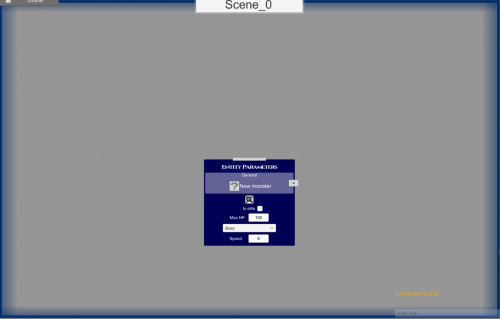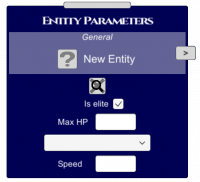Difference between revisions of "Getting Started"
| Line 91: | Line 91: | ||
Phases also have conditions to decide whether or not to active them, as we will discover right now. | Phases also have conditions to decide whether or not to active them, as we will discover right now. | ||
| + | |||
| + | [[fr:Démarrage]] | ||
Revision as of 15:20, 4 September 2018
Contents
Introduction
In Cellyon, you can create your own bosses and levels ! You can script their behaviors, their phases, their targets, make some news spells with customizable appearance, create custom classes, define objectives, and much more.
The idea for creating a boss editor came from the observation that most MMORPG bosses were not very complex. Most of the time, their behavior consists in a series of events that modify the game state (for example removing X from the players’ health or spawning another entity), according to certain conditions.
By presenting this behavior as a node editor, we're making it much more accessible, and through this tutorial you will be able to quickly learn how the editor works, but it assumes you already know the basics of MMO boss fighting (concepts of phases, threat..). If not, it is recommended that you check this tutorial first.
Objectives
Here are the list of things you will create along this tutorial. Together we will make a simple but effective boss fight that provides a good start for more complex ones later.
- A new custom level
- A main boss
- A spell
- An aoe
Creating a new level
Let's start by creating a level. To do so, simply select the ![]() button from the main menu
button from the main menu
On the left panel are your custom levels, for now it is most likely empty but if you want to continue you work on a level, simply select it in this list and it will get loaded in the editor.
For now let's create a new one with the ![]() button
button
You should see the battle ring in the center of the screen. There are many different environments that you can use to create your levels, but let's start with this one since it is the simplest.
Camera Movements
Start by looking around the map. You can move the camera by pressing one of the mouse clicks and dragging it on the screen.
With the left click you can translate the camera above the map, and with the right click you can rotate it.
First Entity
Now it is time to populate the boss room !
In Cellyon, anything that appears in the scene in called a entity. There are three kinds of entities : ▪ monsters ▪ aoes and ▪ spawn areas
The key concept to understand is that to be present on the map, the entity must be spawned one way or another.
Several instances of the same entity can be in the game at the same time, and they will all have the same scripted behavior.
They are 2 ways to spawn an entity, it either is spawned from the beginning of the level or as a effect of a spell, but we'll come back to it later.
For now let's create our first entity.
To do so, simply click the ![]() button in the top right corner of the screen, then the
button in the top right corner of the screen, then the ![]() in the dropdown that opens.
in the dropdown that opens.
This creates a editor page to script the behavior of the entity, plus a tab to access it from the tab panel : ![]()
This is the starting point to describe the behavior of the boss. First, we can set his main characteristics directly into the base entity node
You can start by renaming it by clicking on "New Entity" and changing its icon by clicking on the ![]() button
button
For the remaining of the tutorial it will be referred to as "My Boss"
Then you can check the "Is Elite" toggle so the UI corresponds to the rank of your monster, and slightly increase its Max HP (300 is good for a solo boss)
In the dropdown, you can chose what model you want for your boss among the ones available.
Finally, a Speed of 8 of higher is advised so the boss cannot be too easily kitted.
First Phase
Right now the boss is already pretty impressive, but it doesn't do anything, so the next step would be to give him abilities so he can attack.
To allow a progression in the difficulty of the fight. The behavior or a monster is divided into phases. You can see them as drawers containing spells, and only the ones in drawers that are currently opened (active) can be used.
Basically, the spells all have a casting condition and are launched as soon as it is fulfilled, but only the conditions of the spells belonging to active phases are checked.
Phases also have conditions to decide whether or not to active them, as we will discover right now.

